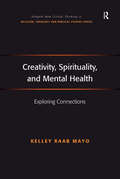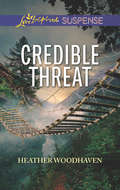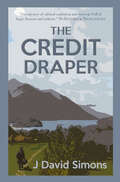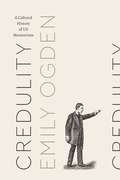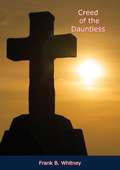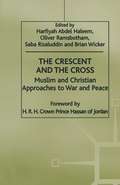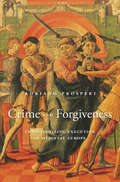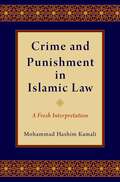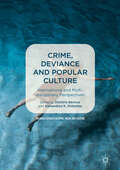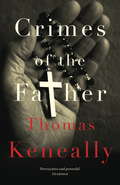- Table View
- List View
Creativity, Religion and Youth Cultures (Routledge Advances in Critical Diversities)
by Anne M. HarrisThis book explores the rich intersection between faith, religion and performing arts in culture-based youth groups. The co-constitutive identity-building work of music, performance, and drama for Samoan and Sudanese youth in church contexts has given rise to new considerations of diversity, cultural identity and the religious practices and rituals that inform them. For these young people, their culture-specific churches provide a safe if "imagined community" (Anderson, 2006) in which they can express these emerging identities, which move beyond simple framings like "multicultural" to explicitly include faith practices. These identities emerge in combination with popular cultural art forms like hip hop, R-&-B and gospel music traditions, and performance influences drawn from American, British and European popular cultural forms (including fashion, reality television, social media, gaming, and online video-sharing). The book also examines the ways in which diasporic experiences are reshaping these cultural and gendered identities and locations.
Creativity, Spirituality, and Mental Health: Exploring Connections (Routledge New Critical Thinking in Religion, Theology and Biblical Studies)
by Kelley Raab MayoThis book emphasizes the integral connections between imagination, creativity, and spirituality and their role in healing. First, the author highlights the work of a neglected yet important psychoanalyst, Marion Milner - a painter and undeclared mystic - expanding her work on creativity, mysticism, and mental health. Second, she explores imagination and creativity as expressed in fostering hope and in spiritually-oriented therapies, particularly for mood, anxiety, and eating disorders - offering practical application of studies in imagination and the arts. Raab Mayo concludes that both creativity and the potential for transcendence are inherent in the human psyche and can work as allies in the process of recovery from mental illness.
Creativity, Spirituality, and Mental Health: Exploring Connections (Routledge New Critical Thinking in Religion, Theology and Biblical Studies)
by Kelley Raab MayoThis book emphasizes the integral connections between imagination, creativity, and spirituality and their role in healing. First, the author highlights the work of a neglected yet important psychoanalyst, Marion Milner - a painter and undeclared mystic - expanding her work on creativity, mysticism, and mental health. Second, she explores imagination and creativity as expressed in fostering hope and in spiritually-oriented therapies, particularly for mood, anxiety, and eating disorders - offering practical application of studies in imagination and the arts. Raab Mayo concludes that both creativity and the potential for transcendence are inherent in the human psyche and can work as allies in the process of recovery from mental illness.
Credible Threat: Baby On The Run Credible Threat High-risk Investigation (Mills And Boon Love Inspired Suspense Ser.)
by Heather WoodhavenNO SAFE PLACE
The Credit Draper
by J David Simons"A truly fine debut" Rodge Glass. 1911. Avram Escovitz, a young Jew, arrives in Glasgow from Russia. He dreams of playing football until WWI intervenes and he begins work as a credit draper, peddling goods to Highlanders. A stranger in a strange land, Avram must set up a new business and capture the heart of a Highland lass. But how easy will it be to shake off his Jewish roots? *New revised edition
Credulity: A Cultural History of US Mesmerism (Class 200: New Studies in Religion)
by Emily OgdenFrom the 1830s to the Civil War, Americans could be found putting each other into trances for fun and profit in parlors, on stage, and in medical consulting rooms. They were performing mesmerism. Surprisingly central to literature and culture of the period, mesmerism embraced a variety of phenomena, including mind control, spirit travel, and clairvoyance. Although it had been debunked by Benjamin Franklin in late eighteenth-century France, the practice nonetheless enjoyed a decades-long resurgence in the United States. Emily Ogden here offers the first comprehensive account of those boom years. Credulity tells the fascinating story of mesmerism’s spread from the plantations of the French Antilles to the textile factory cities of 1830s New England. As it proliferated along the Eastern seaboard, this occult movement attracted attention from Ralph Waldo Emerson’s circle and ignited the nineteenth-century equivalent of flame wars in the major newspapers. But mesmerism was not simply the last gasp of magic in modern times. Far from being magicians themselves, mesmerists claimed to provide the first rational means of manipulating the credulous human tendencies that had underwritten past superstitions. Now, rather than propping up the powers of oracles and false gods, these tendencies served modern ends such as labor supervision, education, and mediated communication. Neither an atavistic throwback nor a radical alternative, mesmerism was part and parcel of the modern. Credulity offers us a new way of understanding the place of enchantment in secularizing America.
Credulity: A Cultural History of US Mesmerism (Class 200: New Studies in Religion)
by Emily OgdenFrom the 1830s to the Civil War, Americans could be found putting each other into trances for fun and profit in parlors, on stage, and in medical consulting rooms. They were performing mesmerism. Surprisingly central to literature and culture of the period, mesmerism embraced a variety of phenomena, including mind control, spirit travel, and clairvoyance. Although it had been debunked by Benjamin Franklin in late eighteenth-century France, the practice nonetheless enjoyed a decades-long resurgence in the United States. Emily Ogden here offers the first comprehensive account of those boom years. Credulity tells the fascinating story of mesmerism’s spread from the plantations of the French Antilles to the textile factory cities of 1830s New England. As it proliferated along the Eastern seaboard, this occult movement attracted attention from Ralph Waldo Emerson’s circle and ignited the nineteenth-century equivalent of flame wars in the major newspapers. But mesmerism was not simply the last gasp of magic in modern times. Far from being magicians themselves, mesmerists claimed to provide the first rational means of manipulating the credulous human tendencies that had underwritten past superstitions. Now, rather than propping up the powers of oracles and false gods, these tendencies served modern ends such as labor supervision, education, and mediated communication. Neither an atavistic throwback nor a radical alternative, mesmerism was part and parcel of the modern. Credulity offers us a new way of understanding the place of enchantment in secularizing America.
Credulity: A Cultural History of US Mesmerism (Class 200: New Studies in Religion)
by Emily OgdenFrom the 1830s to the Civil War, Americans could be found putting each other into trances for fun and profit in parlors, on stage, and in medical consulting rooms. They were performing mesmerism. Surprisingly central to literature and culture of the period, mesmerism embraced a variety of phenomena, including mind control, spirit travel, and clairvoyance. Although it had been debunked by Benjamin Franklin in late eighteenth-century France, the practice nonetheless enjoyed a decades-long resurgence in the United States. Emily Ogden here offers the first comprehensive account of those boom years. Credulity tells the fascinating story of mesmerism’s spread from the plantations of the French Antilles to the textile factory cities of 1830s New England. As it proliferated along the Eastern seaboard, this occult movement attracted attention from Ralph Waldo Emerson’s circle and ignited the nineteenth-century equivalent of flame wars in the major newspapers. But mesmerism was not simply the last gasp of magic in modern times. Far from being magicians themselves, mesmerists claimed to provide the first rational means of manipulating the credulous human tendencies that had underwritten past superstitions. Now, rather than propping up the powers of oracles and false gods, these tendencies served modern ends such as labor supervision, education, and mediated communication. Neither an atavistic throwback nor a radical alternative, mesmerism was part and parcel of the modern. Credulity offers us a new way of understanding the place of enchantment in secularizing America.
Credulity: A Cultural History of US Mesmerism (Class 200: New Studies in Religion)
by Emily OgdenFrom the 1830s to the Civil War, Americans could be found putting each other into trances for fun and profit in parlors, on stage, and in medical consulting rooms. They were performing mesmerism. Surprisingly central to literature and culture of the period, mesmerism embraced a variety of phenomena, including mind control, spirit travel, and clairvoyance. Although it had been debunked by Benjamin Franklin in late eighteenth-century France, the practice nonetheless enjoyed a decades-long resurgence in the United States. Emily Ogden here offers the first comprehensive account of those boom years. Credulity tells the fascinating story of mesmerism’s spread from the plantations of the French Antilles to the textile factory cities of 1830s New England. As it proliferated along the Eastern seaboard, this occult movement attracted attention from Ralph Waldo Emerson’s circle and ignited the nineteenth-century equivalent of flame wars in the major newspapers. But mesmerism was not simply the last gasp of magic in modern times. Far from being magicians themselves, mesmerists claimed to provide the first rational means of manipulating the credulous human tendencies that had underwritten past superstitions. Now, rather than propping up the powers of oracles and false gods, these tendencies served modern ends such as labor supervision, education, and mediated communication. Neither an atavistic throwback nor a radical alternative, mesmerism was part and parcel of the modern. Credulity offers us a new way of understanding the place of enchantment in secularizing America.
Credulity: A Cultural History of US Mesmerism (Class 200: New Studies in Religion)
by Emily OgdenFrom the 1830s to the Civil War, Americans could be found putting each other into trances for fun and profit in parlors, on stage, and in medical consulting rooms. They were performing mesmerism. Surprisingly central to literature and culture of the period, mesmerism embraced a variety of phenomena, including mind control, spirit travel, and clairvoyance. Although it had been debunked by Benjamin Franklin in late eighteenth-century France, the practice nonetheless enjoyed a decades-long resurgence in the United States. Emily Ogden here offers the first comprehensive account of those boom years. Credulity tells the fascinating story of mesmerism’s spread from the plantations of the French Antilles to the textile factory cities of 1830s New England. As it proliferated along the Eastern seaboard, this occult movement attracted attention from Ralph Waldo Emerson’s circle and ignited the nineteenth-century equivalent of flame wars in the major newspapers. But mesmerism was not simply the last gasp of magic in modern times. Far from being magicians themselves, mesmerists claimed to provide the first rational means of manipulating the credulous human tendencies that had underwritten past superstitions. Now, rather than propping up the powers of oracles and false gods, these tendencies served modern ends such as labor supervision, education, and mediated communication. Neither an atavistic throwback nor a radical alternative, mesmerism was part and parcel of the modern. Credulity offers us a new way of understanding the place of enchantment in secularizing America.
Credulity: A Cultural History of US Mesmerism (Class 200: New Studies in Religion)
by Emily OgdenFrom the 1830s to the Civil War, Americans could be found putting each other into trances for fun and profit in parlors, on stage, and in medical consulting rooms. They were performing mesmerism. Surprisingly central to literature and culture of the period, mesmerism embraced a variety of phenomena, including mind control, spirit travel, and clairvoyance. Although it had been debunked by Benjamin Franklin in late eighteenth-century France, the practice nonetheless enjoyed a decades-long resurgence in the United States. Emily Ogden here offers the first comprehensive account of those boom years. Credulity tells the fascinating story of mesmerism’s spread from the plantations of the French Antilles to the textile factory cities of 1830s New England. As it proliferated along the Eastern seaboard, this occult movement attracted attention from Ralph Waldo Emerson’s circle and ignited the nineteenth-century equivalent of flame wars in the major newspapers. But mesmerism was not simply the last gasp of magic in modern times. Far from being magicians themselves, mesmerists claimed to provide the first rational means of manipulating the credulous human tendencies that had underwritten past superstitions. Now, rather than propping up the powers of oracles and false gods, these tendencies served modern ends such as labor supervision, education, and mediated communication. Neither an atavistic throwback nor a radical alternative, mesmerism was part and parcel of the modern. Credulity offers us a new way of understanding the place of enchantment in secularizing America.
The Creed in Slow Motion: An exploration of faith, phrase by phrase, word by word
by Martin KochanskiI believe in one God, the Father almighty, maker of heaven and earth...The Creed is the bones of our faith. In all our different ways, it makes us who we are. But when we stand up and recite the Creed in unison, we have no time to contemplate what it is that we are committing ourselves to. The words rush past, their meaning blurred by familiarity. If we could only slow them down and hear them properly, they would have the power to change worlds. That is what The Creed in Slow Motion aims to do. This is a book for people who like to think things through from first principles. It will not tell you what to believe. (It is for you to engage your mind and discover that for yourself. And for unbelievers to learn what exactly they disbelieve, and why.)In forty short chapters, with clarity and wit, The Creed in Slow Motion draws examples from real-life stories, history and even science to uncover the core claims of Christianity. By turns it is deep, heartening, startling, revolutionary and even, by the world's standards, outrageous.
Creed of the Dauntless
by Frank WhitneyCreed of the Dauntless, which was originally published in 1931, is a presentation of constructive thought and principles for those who would be undaunted, unaffected by adverse beliefs or by external things, victorious in the realization of their innate power to overcome.
The Crescent and the Cross: Muslim and Christian Approaches to War and Peace
by Oliver Ramsbotham Saba Risaluddin Brian Wicker Abdel Haleem HarifyahThis book is the product of dialogue between a group of leading British Muslim and Christian scholars concerned about the alleged danger to the 'West' of Islamic 'fundamentalism'. It analyses the ethical and legal principles, rooted in both traditions, underlying any use of armed force in the modern world. After chapters on the history, theology and laws of war as seen from both sides, the book applies its conclusions to (a) the 1990-91 Gulf War and (b) the Bosnian Conflict. It concludes that Huntington's 'Clash of Civilisations' thesis is a dangerous myth.
Crescent Remembered: Islam and Nationalism on the Iberian Peninsula (Liverpool Studies in Spanish History)
by Patricia HertelContemporary Spain and Portugal share a historical experience as Iberian states which emerged within the context of al-Andalus. These centuries of Muslim presence in the Middle Ages became a contested heritage during the process of modern nation-building with its varied concepts and constructs of national identities. Politicians, historians and intellectuals debated vigorously the question how the Muslim past could be reconciled with the idea of the Catholic nation. The Crescent Remembered investigates the processes of exclusion and integration of the Islamic past within the national narratives. It analyses discourses of historiography, Arabic studies, mythology, popular culture and colonial policies towards Muslim populations from the 19th century to the dictatorships of Franco and Salazar in the 20th century. In particular, it explores why, despite apparent historical similarities, in Spain and Portugal entirely different strategies and discourses concerning the Islamic past emerged. In the process, it seeks to shed light on the role of the Iberian Peninsula as a crucial European historical "contact zone" with Islam.
Crime and Forgiveness: Christianizing Execution in Medieval Europe
by Adriano ProsperiA provocative analysis of how Christianity helped legitimize the death penalty in early modern Europe, then throughout the Christian world, by turning execution into a great cathartic public ritual and the condemned into a Christ-like figure who accepts death to save humanity. The public execution of criminals has been a common practice ever since ancient times. In this wide-ranging investigation of the death penalty in Europe from the fourteenth to the eighteenth century, noted Italian historian Adriano Prosperi identifies a crucial period when legal concepts of vengeance and justice merged with Christian beliefs in repentance and forgiveness. Crime and Forgiveness begins with late antiquity but comes into sharp focus in fourteenth-century Italy, with the work of the Confraternities of Mercy, which offered Christian comfort to the condemned and were for centuries responsible for burying the dead. Under the brotherhoods’ influence, the ritual of public execution became Christianized, and the doomed person became a symbol of the fallen human condition. Because the time of death was known, this “ideal” sinner could be comforted and prepared for the next life through confession and repentance. In return, the community bearing witness to the execution offered forgiveness and a Christian burial. No longer facing eternal condemnation, the criminal in turn publicly forgave the executioner, and the death provided a moral lesson to the community. Over time, as the practice of Christian comfort spread across Europe, it offered political authorities an opportunity to legitimize the death penalty and encode into law the right to kill and exact vengeance. But the contradictions created by Christianity’s central role in executions did not dissipate, and squaring the emotions and values surrounding state-sanctioned executions was not simple, then or now.
Crime and Punishment in Islamic Law: A Fresh Interpretation
by Mohammad Hashim KamaliIn Crime and Punishment in Islamic Law: A Fresh Interpretation, Mohammad Kamali considers problems associated with and proposals for reform of the hudud punishments prescribed by Islamic criminal law, and other topics related to crime and punishment in Shariah. He examines what the Qur'an and hadith say about hudud punishments, as well as just retaliation (qisas), and discretionary punishments (ta'zir), and looks at modern-day applications of Islamic criminal law in 15 Muslim countries. Particular attention is given to developments in Malaysia, a multi-religious society, federal state, and self-described democracy, where a lively debate about hudud has been on-going for the last three decades. Malaysia presents a particularly interesting case study of how a reasonably successful country with a market economy, high levels of exposure to the outside world, and a credible claim to inclusivity, deals with Islamic and Shariah-related issues. Kamali concludes that there is a significant gap between the theory and practice of hudud in the scriptural sources of Shariah and the scholastic articulations of jurisprudence of the various schools of Islamic law, arguing that literalism has led to such rigidity as to make Islamic criminal law effectively a dead letter. His goal is to provide a fresh reading of the sources of Shariah and demonstrate how the Qur'an and Sunnah can show the way forward to needed reforms of Islamic criminal law.
Crime and Punishment in Islamic Law: A Fresh Interpretation
by Mohammad Hashim KamaliIn Crime and Punishment in Islamic Law: A Fresh Interpretation, Mohammad Kamali considers problems associated with and proposals for reform of the hudud punishments prescribed by Islamic criminal law, and other topics related to crime and punishment in Shariah. He examines what the Qur'an and hadith say about hudud punishments, as well as just retaliation (qisas), and discretionary punishments (ta'zir), and looks at modern-day applications of Islamic criminal law in 15 Muslim countries. Particular attention is given to developments in Malaysia, a multi-religious society, federal state, and self-described democracy, where a lively debate about hudud has been on-going for the last three decades. Malaysia presents a particularly interesting case study of how a reasonably successful country with a market economy, high levels of exposure to the outside world, and a credible claim to inclusivity, deals with Islamic and Shariah-related issues. Kamali concludes that there is a significant gap between the theory and practice of hudud in the scriptural sources of Shariah and the scholastic articulations of jurisprudence of the various schools of Islamic law, arguing that literalism has led to such rigidity as to make Islamic criminal law effectively a dead letter. His goal is to provide a fresh reading of the sources of Shariah and demonstrate how the Qur'an and Sunnah can show the way forward to needed reforms of Islamic criminal law.
Crime and the Imaginary of Disaster: Post-Apocalyptic Fictions and the Crisis of Social Order
by M. YarThis study explores the 'imaginary of disaster' that appears in popular fictions about the apocalyptic breakdown of society. Focusing on representations of crime, law, violence, vengeance and justice, it argues that an exploration post-apocalyptic story-telling offer us valuable insights into social anxieties.
Crime, Criminal Justice and Religion: A Critical Appraisal (Routledge Studies in Crime and Society)
by Philip Birch Conor Murray Andrew McInnesCrime, Criminal Justice and Religion: A Critical Appraisal seeks to bridge a gap in the examination of crime and criminal justice by taking both a historical and a contemporary lens to explore the influence of religion. Offering unique perspectives that consider the impact on modern-day policy and practice, the book scrutinises a range of issues such as abortion, hate crime and desistance as well as reflecting upon the influence religion can have on criminal justice professions. The book acts to renew the importance of, and recognise, the influence and impact religion has in terms of how we view and ultimately address crime and deliver criminal justice. One of the first books to cover the area of crime, criminal justice and religion, the book is split into three parts, with part 1 - 'Contextualising Crime, Criminal Justice and Religion' - providing an introduction to crime, criminal justice and religion, and reflections on the role religion has had, and continues to have, in how crime is understood and how we respond to it. Part 2 - 'Appraisal of Institutions and Professional Practice' - considers the issue of religion through institutions and professions of criminal justice, such as the police and legal profession, while part 3 - 'Appraisal of Contemporary Issues' - explores a range of crime and criminal justice issues in on which religion has had an impact, such as the death penalty and terrorism. Crime, Criminal Justice and Religion will be of primary interest to academics, researchers and students in criminology, law, sociology, psychology, social policy and related Humanities, Arts and Social Sciences disciplines. It will also be of interest to theologians, both as scholars and practitioners. The book is a body of work that will appeal at an international level and will also be a key resource for a range of practitioners across the globe working on issues concerning crime and criminal justice.
Crime, Criminal Justice and Religion: A Critical Appraisal (Routledge Studies in Crime and Society)
by Philip Birch Conor Murray Andrew McInnesCrime, Criminal Justice and Religion: A Critical Appraisal seeks to bridge a gap in the examination of crime and criminal justice by taking both a historical and a contemporary lens to explore the influence of religion. Offering unique perspectives that consider the impact on modern-day policy and practice, the book scrutinises a range of issues such as abortion, hate crime and desistance as well as reflecting upon the influence religion can have on criminal justice professions. The book acts to renew the importance of, and recognise, the influence and impact religion has in terms of how we view and ultimately address crime and deliver criminal justice. One of the first books to cover the area of crime, criminal justice and religion, the book is split into three parts, with part 1 - 'Contextualising Crime, Criminal Justice and Religion' - providing an introduction to crime, criminal justice and religion, and reflections on the role religion has had, and continues to have, in how crime is understood and how we respond to it. Part 2 - 'Appraisal of Institutions and Professional Practice' - considers the issue of religion through institutions and professions of criminal justice, such as the police and legal profession, while part 3 - 'Appraisal of Contemporary Issues' - explores a range of crime and criminal justice issues in on which religion has had an impact, such as the death penalty and terrorism. Crime, Criminal Justice and Religion will be of primary interest to academics, researchers and students in criminology, law, sociology, psychology, social policy and related Humanities, Arts and Social Sciences disciplines. It will also be of interest to theologians, both as scholars and practitioners. The book is a body of work that will appeal at an international level and will also be a key resource for a range of practitioners across the globe working on issues concerning crime and criminal justice.
Crime, Deviance and Popular Culture: International and Multidisciplinary Perspectives (Palgrave Studies in Crime, Media and Culture)
by Alexandros K. Antoniou Dimitris AkrivosThis book explores the links between crime, deviance and popular culture in our highly-mediatised era, offering an insight into the cultural processes through which particular practices acquire a criminal or deviant status, and come to be seen as social problems. Adopting a multidisciplinary approach, the edited collection brings together international scholars across various areas of specialisation to provide an up-to-date analysis of some important and topical issues in 21st-century popular culture. The chapters look at different aspects of popular culture, including fictional detective narratives and the true crime genre, popular media constructions of sexual deviance and Islamophobia, sports, graffiti and outlaw biker subcultures. The authors examine a wide range of relevant case studies through a number of crime and deviance-related theories. Crime, Deviance and Popular Culture will be of importance to scholars and students across several disciplines, including criminology, sociology of deviance, social anthropology, media studies, cultural studies, television studies and linguistics.
Crime, Prisons and Viscous Culture: Adventures in Criminalized Identities
by Finola FarrantThis unique book explores criminalized identities and the idea of 'viscous culture' to provide new understandings of crime, punishment and justice. It shows that viscous culture encourages some of us to become outlaws, monsters or shapeshifters who challenge systems of domination and forces of control. Crime, Prisons and Viscous Culture interweaves analyses of popular culture with extensive empirical research to explore both the glamorous and grotesque nature of crime, control and containment. Through encounters with numerous popular and mythological archetypes the book explores the boundaries of the criminological discipline. Criminology itself is presented as fragmented, distorted and fascinating, and the important transdisciplinary potential of criminology is highlighted. In doing so, this book will be of great interest to scholars of criminology, cultural studies, popular culture and sociological theory.
Crimes of the Father: A Novel
by Thomas KeneallyThomas Keneally pulls no punches in this powerful novel about the Catholic Church's attempts to cover up cases of child abuse, and a priest who decides to help its innocent victims' fight to be heard.Expelled from the archdiocese of Sydney as a young priest for his outspoken views on the Vietnam War, Father Frank Docherty returns to Australia in 1996 to speak at a conference on paedophilia within the Catholic Church. He had hoped to spend time with his mother and old friends. Instead, he finds himself caught up in the cases of two people who claim to have been sexually abused by an eminent Sydney cleric - one the son of Docherty's former parishioner, the other a former nun. And the cleric in question is brother to the woman Docherty fell in love with many years before. If the accusations are true, the consequences for many will be devastating, but Docherty has to follow his conscience. In this riveting, profoundly thoughtful novel, Thomas Keneally draws on his own experience as an ex-seminarian to bring alive matters of faith, celibacy, perversion and marriage. Portraying the Catholic Church at a pivotal moment, he shows that its prevarications and cover-ups wreaked terrible damage not only on innocents but on itself, with toxic repercussions to this day.
Criminal Justice: Retribution vs. Restoration
by Eleanor Hannon JudahThere are nearly two million inmates in America today. Are there better alternatives to incarceration? Criminal Justice: Retribution vs. Restoration presents new answers and unconventional suggestions addressing America&’s overcrowded prisons and jails, high recidivism rates, and weakened family and community relationships with ex-prisoners. Experts in the field discuss the benefits and failures of America&’s criminal justice system at various times in history and today, then explore possibilities to improve on that system. This groundbreaking book introduces encouraging, therapeutic approaches to criminal justice that include treatment, rehabilitation, and the direct involvement the victims, the families, and the communities. Criminal Justice looks at America&’s over-reliance on punishment and retribution as the means of responding to prevalent social problems and examines the justice system&’s tendency to incarcerate-rather than treat-minority, mentally ill, poor, and drug-dependent offenders. The authors-who are all active in some field of criminal justice-argue for a restorative model of correction that is more humane to both offenders and victims. This model opens up dialogue between offenders and their victims, families, and communities by promoting hallmark programs, including victim offender mediation, conferencing, peacemaking circles, restitution, and community projects and services. Criminal Justice includes such intriguing topics as: the social costs and moral economy of incarceration drug policy-should drug users be incarcerated or rehabilitated? the potential of restorative justice-a first-hand account from a prison inmate restorative justice and faith communities the practice and efficacy of restorative justice the path from fury to forgiveness-the emotions of the mother of a murdered child strategies for creating safe and just communities women in prison-their special needs both during incarceration and after re-entry social work and criminal justice-how they work together grassroots advocacy for criminal justice reform-a look back over the last 30 years by the founders of CURE (Citizens United for Rehabilitation of Errants) This book&’s foundation rests on the Biblical concepts of restoration, healing, forgiveness, reconciliation, and responsibility. Criminal Justice: Retribution vs Restoration is an eye-opening look at the negative effects of our current system of blame and punishment and offers hope for better, more humane methods in the future. This holistic, empowering, and strengths-based perspective offers insight and suggestions that are valuable for students, social workers, policymakers, and criminal justice professionals.

